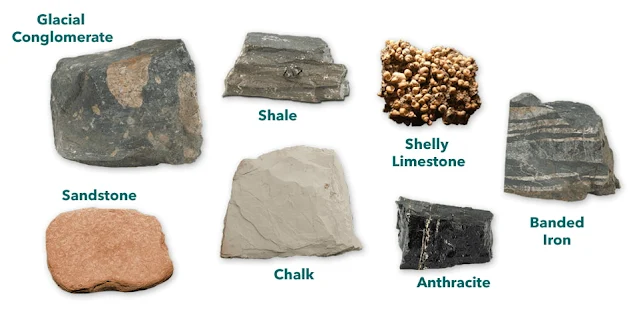How Are Sedimentary Rocks Formed?
Sedimentary rocks form from the gradual accumulation and cementation of mineral and organic particles on the Earth’s surface. They are one of the three main rock types, along with igneous and metamorphic rocks. Understanding the processes that create sedimentary rocks gives insights into the history of the Earth’s crust and climatic conditions in the geological past.
The Role of Weathering and Erosion
The formation of sedimentary rocks begins with the weathering and erosion of existing rocks at the Earth’s surface. Rocks are broken down into smaller fragments through mechanical and chemical weathering processes. Mechanical weathering physically breaks rocks into smaller pieces through freezing and thawing, plant root growth, abrasion by glaciers and gravity. Chemical weathering alters the mineral composition of rocks by reactions such as oxidation, hydration, carbonation and acid hydrolysis.
This weathered rock debris is transported by wind, water, ice and gravity to areas of lower elevation. Streams carry sediment loads in suspension while glaciers scrape and grind bedrock. Strong winds pick up and carry fine particles. The collective movement of weathered rock and mineral fragments is known as erosion.
Deposition of Sediments
When the forces of erosion decrease, the transported debris is eventually deposited. This typically occurs when a river enters a lake or ocean, reducing its capacity to carry sediment. Sediments dropped in this manner are known as mechanical sediments. Chemical sediments precipitate directly from solution. Evaporation can lead to the deposition of salt beds and chert nodules, while mineral-rich waters precipitate substances like calcite and hematite.
Over time, continued deposition leads to the accumulation of sediment in layers. Coarser, heavier particles drop out first while finer silt and clay particles are carried farther by moving water. Each layer records the sedimentary environment at the time of deposition. Sediment deposits accumulate vertically and laterally as basins gradually fill.
Common Sedimentary Environments
The most common sedimentary environments where deposition occurs include:
- Alluvial fans - fan-shaped deposits formed where steep mountain streams flow out onto flat land.
- Deltas - sediment accumulations at a river's mouth due to changing flow velocities.
- Floodplains - broad, flat areas adjacent to rivers periodically covered by water.
- Beaches - shoreline sediments moved by waves and coastal currents.
- Dunes - mounds of sand sized sediment blown by the wind.
- Lacustrine - sediments deposited in lake environments.
- Marine - ocean floor sediments covering over 70% of the Earth's surface.
Lithification and Compaction
Once deposited, continued compaction squeezes sediments and reduces pore space. Lithification converts loose sediment to solid rock through processes like cementation, recrystallization and dewatering. The pressure of overlying sediments forces particles together, expelling fluids and promoting chemical changes at points of contact.
Cementation occurs when dissolved minerals precipitate between sediment grains, acting as natural cement. Calcite, silica and iron oxides are common cements. Recrystallization involves the dissolution and reprecipitation of minerals into more stable crystalline forms.
Common Sedimentary Rock Types
The sedimentary rocks formed through lithification include:
- Conglomerate - cemented rounded gravel and boulders.
- Breccia - angular gravel-sized clasts embedded in finer grained matrix.
- Sandstone - cemented quartz grains and siliclastics.
- Siltstone - lithified silt-sized particles, often with lamination.
- Shale - compacted and cemented mud and clay.
- Limestone - calcium carbonate mud, ooids, shell fragments or calcite cement.
- Coal - organic matter that accumulates in swamps and bogs.
- Chert - microcrystalline or crypto crystalline quartz.
- Iron formations - alternating iron oxide and silica layers.
- Rock salt - precipitated NaCl crystals.
The Rock Cycle Connection
Sedimentary rocks are one link in the endless rock cycle. They may be buried more deeply, heated and pressurized enough to become metamorphic. In areas of extreme tectonic activity, they can melt into magma that crystallizes into igneous intrusions. Uplift and erosion eventually expose them back at the surface to begin the sedimentary cycle again.
Studying sedimentary rocks reveals much about the depositional settings and environments where the original sediments accumulated. Fossils trace the evolution of life, while mineral variations reflect climate change over geological timescales. These rocks provide a window into the distant past like no other.
Key Takeaways
- Sedimentary rocks form from the lithification of deposited mineral and organic particles.
- Weathering and erosion produce the sediments that become protoliths.
- Deposition occurs when sediments are laid down in specific environments.
- Compaction and cementation convert sediments into solid rock.
- Common sedimentary rock types include conglomerate, sandstone, shale, limestone and coal.
- Sedimentary rocks are linked to the rock cycle and provide insights into Earth's past.







0 Comments